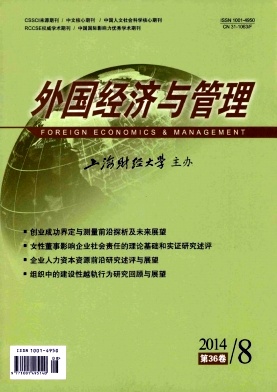企业人力资本资源前沿研究述评与展望——基于分层面视角
外国经济与管理 2014 年 第 36 卷第 08 期, 页码:33 - 44
摘要
参考文献
摘要
企业分层面理论的发展使得战略管理、战略人力资源管理与心理学交叉领域的研究越来越受到关注,企业利用人力资本资源获取持续竞争优势的内在机理得到越来越深刻的揭示。本文通过对相关文献的回顾,首先基于分层面理论对人力资本资源的内涵以及组合与突现问题进行了分析,然后解析了人力资本资源的持续竞争优势以及分层面中介作用和"伴随"因素,最后对人力资本资源的未来研究方向进行了展望。
[1]Aryee S,et al.Developing and leveraging human capital resource to promote service quality:Testing a theory of performance[J]Journal of Management,In press.
[2]Becker B E and Huselid M A.Strategic human resources management:Where do we go from here?[J].Journal of Management,2006,32(6):898-925.
[3]Blitz D.Emergent evolution:Qualitative novelty and the levels of reality[M].Dordrecht:Kluwer Academic Publishers,1992.
[4]Bowen D E and Ostroff C.Understanding HRM-firm performance linkages:The role of the“strength”of the HRM system[J].Academy of Management Review,2004,29(2):203-221.
[5]Buller P F and McEvoy G M.Strategy,human resource management and performance:Sharpening line of sight[J].Human Resource Management Review,2012,22(1):43-56.
[6]Campbell B A,et al.Rethinking sustained competitive advantage from human capital[J].Academy of Management Review,2012,37(3):376-395.
[7]Coff R and Kryscynski D.Invited editorial:Drilling for micro-foundations of human capital-based competitive advantages[J].Journal of Management,2011,37(5):1429-1443.
[8]Colbert B A.The complex resource-based view:Implications for theory and practice in strategic human resource management[J].Academy of Management Review,2004,29(3):341-358.
[9]Crook T R,et al.Does human capital matter?A meta-analysis of the relationship between human capital and firm performance[J].Journal of Applied Psychology,2011,96(3):443-456.
[10]Fulmer I S and Ployhart R E.“Our most important asset”—A multidisciplinary/multilevel review of human capital valuation for research and practice[J].Journal of Management,2014,40(1):161-192.
[11]Jackson S E,et al.An aspirational framework for strategic human resource management[J].Academy of Management Annals,2014,8(1):1-56.
[12]Jiang K,et al.Where do we go from here?New perspectives on the black box in strategic human resource management research[J].Journal of Management Studies,2013,50(8):1448-1480.
[13]Kim S,et al.Human resource management and firm performance in China:A critical review[J].Asia Pacific Journal of Human Resources,2010,48(1):58-85.
[14]Kozlowski S W J and Klein K J.A multilevel approach to theory and research in organizations:Contextual,temporal,and emergent processes[A].Klein K J and Kozlowski S W J(Eds.).Multilevel theory,research,and methods in organizations:Foundations,extensions,and new directions[C].San Francisco,CA:Jossey-Bass,2000:3-90.
[15]Kozlowski S W J,et al.Advancing multilevel research design capturing the dynamics of emergence[J].Organizational Research Methods,2013,16(4):581-615.
[16]Lepak D P,et al.Strategic HRM moving forward:What can we learn from micro perspectives?[J].International Review of Industrial and Organizational Psychology,2012,27:231-258.
[17]Mathieu J E,et al.A review and integration of team composition models moving toward a dynamic and temporal framework[J].Journal of Management,2014,40(1):130-160.
[18]McClean E and Collins C J.High-commitment HR practices,employee effort,and firm performance:Investigating the effects of HR practices across employee groups within professional services firms[J].Human Resource Management,2011,50(3):341-363.
[19]Morgeson F P and Hofmann D A.The structure and function of collective constructs:Implications for multilevel research and theory development[J].Academy of Management Review,1999,24(2):249-265.
[20]Nyberg A J and Ployhart R E.Context-emergent turnover(CET)theory:A theory of collective turnover[J].Academy of Management Review,2013,38(1):109-131.
[21]Ployhart R E and Hale D.The fascinating psychological microfoundations of strategy and competitive advantage[J].Organizational Psychology and Organizational Behavior,2014,1:145-172.
[22]Ployhart R E and Moliterno T P.Emergence of the human capital resource:A multilevel model[J].Academy of Management Review,2011,36(1):127-150.
[23]Ployhart R E,et al.Human capital is dead;long live human capital resources![J].Journal of Management,2014,40(2):371-398.
[24]Ployhart R E.The psychology of competitive advantage:An adjacent possibility[J].Industrial and Organizational Psychology,2012,5(1):62-81.
[25]Resick C J,et al.Information elaboration and team performance:Examining the psychological origins and environmental contingencies[J].Organizational Behavior and Human Decision Processes,2014,124(2):165-176.
[26]Schuler R S and Jackson S E.Linking competitive strategies with human resource management practices[J].Academy of Management Executive,1987,1(3):207-219.
[27]Wright P M,et al.Human resources and the resource based view of the firm[J].Journal of Management,2001,27(6):701-721.
[28]Wright P M,et al.Strategic human capital:Crossing the great divide[J].Journal of Management,2014,40(2):353-370.
[2]Becker B E and Huselid M A.Strategic human resources management:Where do we go from here?[J].Journal of Management,2006,32(6):898-925.
[3]Blitz D.Emergent evolution:Qualitative novelty and the levels of reality[M].Dordrecht:Kluwer Academic Publishers,1992.
[4]Bowen D E and Ostroff C.Understanding HRM-firm performance linkages:The role of the“strength”of the HRM system[J].Academy of Management Review,2004,29(2):203-221.
[5]Buller P F and McEvoy G M.Strategy,human resource management and performance:Sharpening line of sight[J].Human Resource Management Review,2012,22(1):43-56.
[6]Campbell B A,et al.Rethinking sustained competitive advantage from human capital[J].Academy of Management Review,2012,37(3):376-395.
[7]Coff R and Kryscynski D.Invited editorial:Drilling for micro-foundations of human capital-based competitive advantages[J].Journal of Management,2011,37(5):1429-1443.
[8]Colbert B A.The complex resource-based view:Implications for theory and practice in strategic human resource management[J].Academy of Management Review,2004,29(3):341-358.
[9]Crook T R,et al.Does human capital matter?A meta-analysis of the relationship between human capital and firm performance[J].Journal of Applied Psychology,2011,96(3):443-456.
[10]Fulmer I S and Ployhart R E.“Our most important asset”—A multidisciplinary/multilevel review of human capital valuation for research and practice[J].Journal of Management,2014,40(1):161-192.
[11]Jackson S E,et al.An aspirational framework for strategic human resource management[J].Academy of Management Annals,2014,8(1):1-56.
[12]Jiang K,et al.Where do we go from here?New perspectives on the black box in strategic human resource management research[J].Journal of Management Studies,2013,50(8):1448-1480.
[13]Kim S,et al.Human resource management and firm performance in China:A critical review[J].Asia Pacific Journal of Human Resources,2010,48(1):58-85.
[14]Kozlowski S W J and Klein K J.A multilevel approach to theory and research in organizations:Contextual,temporal,and emergent processes[A].Klein K J and Kozlowski S W J(Eds.).Multilevel theory,research,and methods in organizations:Foundations,extensions,and new directions[C].San Francisco,CA:Jossey-Bass,2000:3-90.
[15]Kozlowski S W J,et al.Advancing multilevel research design capturing the dynamics of emergence[J].Organizational Research Methods,2013,16(4):581-615.
[16]Lepak D P,et al.Strategic HRM moving forward:What can we learn from micro perspectives?[J].International Review of Industrial and Organizational Psychology,2012,27:231-258.
[17]Mathieu J E,et al.A review and integration of team composition models moving toward a dynamic and temporal framework[J].Journal of Management,2014,40(1):130-160.
[18]McClean E and Collins C J.High-commitment HR practices,employee effort,and firm performance:Investigating the effects of HR practices across employee groups within professional services firms[J].Human Resource Management,2011,50(3):341-363.
[19]Morgeson F P and Hofmann D A.The structure and function of collective constructs:Implications for multilevel research and theory development[J].Academy of Management Review,1999,24(2):249-265.
[20]Nyberg A J and Ployhart R E.Context-emergent turnover(CET)theory:A theory of collective turnover[J].Academy of Management Review,2013,38(1):109-131.
[21]Ployhart R E and Hale D.The fascinating psychological microfoundations of strategy and competitive advantage[J].Organizational Psychology and Organizational Behavior,2014,1:145-172.
[22]Ployhart R E and Moliterno T P.Emergence of the human capital resource:A multilevel model[J].Academy of Management Review,2011,36(1):127-150.
[23]Ployhart R E,et al.Human capital is dead;long live human capital resources![J].Journal of Management,2014,40(2):371-398.
[24]Ployhart R E.The psychology of competitive advantage:An adjacent possibility[J].Industrial and Organizational Psychology,2012,5(1):62-81.
[25]Resick C J,et al.Information elaboration and team performance:Examining the psychological origins and environmental contingencies[J].Organizational Behavior and Human Decision Processes,2014,124(2):165-176.
[26]Schuler R S and Jackson S E.Linking competitive strategies with human resource management practices[J].Academy of Management Executive,1987,1(3):207-219.
[27]Wright P M,et al.Human resources and the resource based view of the firm[J].Journal of Management,2001,27(6):701-721.
[28]Wright P M,et al.Strategic human capital:Crossing the great divide[J].Journal of Management,2014,40(2):353-370.
引用本文
田立法. 企业人力资本资源前沿研究述评与展望——基于分层面视角[J]. 外国经济与管理, 2014, 36(8): 33–44.
导出参考文献,格式为:





 9311
9311  978
978

